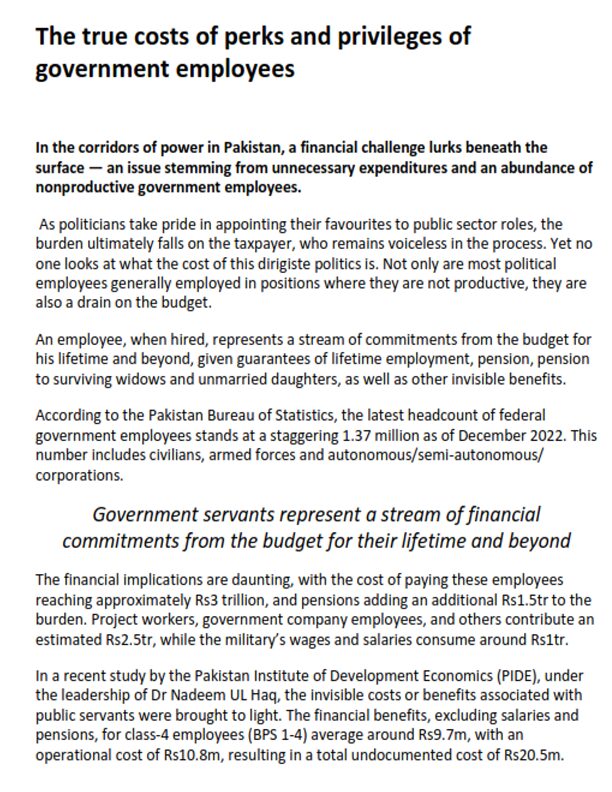
Pakistan Institute of Development Economics
- Home
Our Portals
MenuMenuMenuMenuMenuMenuMenu - ResearchMenuMenuMenuMenuMenuMenuMenu
- Discourse
- The PDR
- Our Researchers
- Academics
- Degree Verification
- Thesis Portal
- Our Portals
The true costs of perks and privileges of government employees
In the corridors of power in Pakistan, a financial challenge lurks beneath the surface — an issue stemming from unnecessary expenditures and an abundance of nonproductive government employees.
As politicians take pride in appointing their favourites to public sector roles, the burden ultimately falls on the taxpayer, who remains voiceless in the process. Yet no one looks at what the cost of this dirigiste politics is. Not only are most political employees generally employed in positions where they are not productive, they are also a drain on the budget.
An employee, when hired, represents a stream of commitments from the budget for his lifetime and beyond, given guarantees of lifetime employment, pension, pension to surviving widows and unmarried daughters, as well as other invisible benefits.
According to the Pakistan Bureau of Statistics, the latest headcount of federal government employees stands at a staggering 1.37 million as of December 2022. This number includes civilians, armed forces and autonomous/semi-autonomous/ corporations.
Government servants represent a stream of financial commitments from the budget for their lifetime and beyond
The financial implications are daunting, with the cost of paying these employees reaching approximately Rs3 trillion, and pensions adding an additional Rs1.5tr to the burden. Project workers, government company employees, and others contribute an estimated Rs2.5tr, while the military’s wages and salaries consume around Rs1tr.
In a recent study by the Pakistan Institute of Development Economics (PIDE), under the leadership of Dr Nadeem UL Haq, the invisible costs or benefits associated with public servants were brought to light. The financial benefits, excluding salaries and pensions, for class-4 employees (BPS 1-4) average around Rs9.7m, with an operational cost of Rs10.8m, resulting in a total undocumented cost of Rs20.5m.
Supporting staff (BPS 5-16) fare even higher, enjoying an average of Rs40.9m worth of benefits not visible on their pay slips. Meanwhile, the perks and privileges of BPS 17 and above skyrocket to an average of Rs470m, shattering the common perception of low salaries in the public sector.
These perks and benefits of civil servants contradict the common perception of low salaries in the public sector. In fact, there are a lot more that are never reflected on their salary slips. These in-kind benefits, which have never been accounted for in the total cost of public servants, include Special Allowances, Medical Reimbursement, and Job Security Discounts.
Similarly, operational expenses (non-salary expenditures) such as the cost of physical space, electricity, telephone and internet, maintenance cost, security for office space, etc, have never been considered as a cost of public servants. The PIDE study argues that if these in-kind benefits were monetised, it would dispel the myth of low public sector salaries.
Furthermore, the study estimates the length of service for public sector employees and the corresponding years of financial liabilities to the government. On average, class-4 employees serve for 39 years (if one assumes they retire in their 60s) and 25 years of service (if they retire after serving 25 years), with government liabilities extending to 53 years.
On average, supporting staff (BPS 5-16) serves for 32 years, with liabilities for 47 years, while BPS 17-19 employees serve for 29 years (if they retire in the 60s), with government liabilities persisting for 44 years.
In Pakistan, high-ranking officials often make politically motivated appointments without assessing the actual need or planning. These poorly executed recruitments not only fail to enhance public sector performance but also burden the government economically. Inefficient recruitment procedures contribute to the low productivity of government departments, particularly autonomous bodies.
The costs of such recruitment can be substantial, both in terms of financial losses and the opportunity cost of lost opportunities. Governments in developing economies often stem from a combination of political motivations, short-term focus, lack of economic expertise, and societal expectations.
While immediate job creation can have positive effects, it’s also crucial for governments to consider the long-term financial implications and strike a balance between short-term gains and sustainable fiscal policies.
Though it might not appear initially, however, when an employee is recruited without any analysis, we are not looking at an immediate salary that is to be paid to that person; we are looking at the burden that taxpayers must carry until that employee or his next of kin is receiving a pension.
The study’s findings underscore a critical need for reevaluating the public sector’s financial structure. While the public perceives low salaries, the hidden costs and benefits reveal a more complex reality. The burden on the budget extends far beyond salaries and pensions, encompassing a myriad of perks and privileges that contribute significantly to the fiscal strain.
As Pakistan grapple with economic challenges, it is imperative to scrutinise and address the intricacies of public sector expenditures. This calls for a transparent dialogue on the true costs of government employment and a collective effort to streamline resources efficiently. Only through a comprehensive understanding of these hidden costs can we pave the way for a more fiscally responsible and sustainable public sector.
The author is a Research Associate at Pakistan Institute of Development Economics (PIDE), Islamabad.



